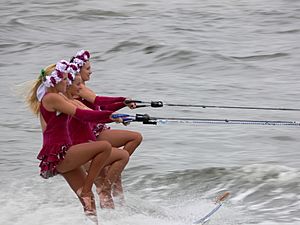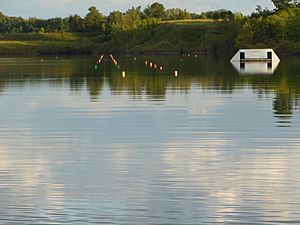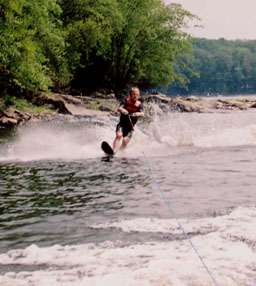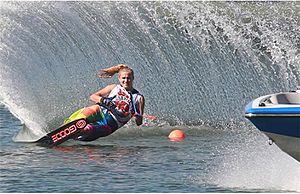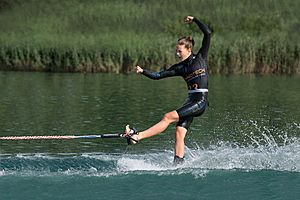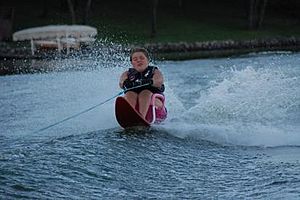Water skiing facts for kids
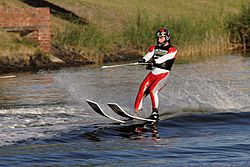
Water skiing on the Yarra River in Melbourne
|
|
| Highest governing body | International Waterski & Wakeboard Federation |
|---|---|
| First played | United States, 1922 |
| Characteristics | |
| Contact | No |
| Mixed-sex | No |
| Type | Aquatic sport |
| Equipment | Water skis, motorboat, towline |
| Venue | Body of water |
| Presence | |
| Olympic | No |
| World Games | 1981 – 2017 |
Water skiing is a fun water sport where a person is pulled by a boat or a special cable system. You glide across the water on two skis or just one. To water ski, you need calm water, skis, a boat with a rope, and a life jacket. It also helps to have good arm and leg strength, stamina, and balance.
People water ski all over the world! You can find skiers in Asia, Australia, Europe, Africa, and the Americas. In the United States, about 11 million people enjoy water skiing. Australia has 1.3 million water skiers. There are also over 900 water ski competitions each year in the U.S.
You can water ski just for fun or to compete. Some types of water skiing include speed skiing, trick skiing, show skiing, and barefoot skiing. Other similar sports are wakeboarding, kneeboarding, and tubing.
Contents
How to Water Ski
Most water skiers start in the water. This is called a "deep-water start." You put your skis on while in the water. Then, the boat throws you a tow rope. You hold the rope between your skis.
To start, you crouch low in the water. Your knees are tucked into your chest. Your skis point up, with about 30 cm (1 foot) out of the water. When you're ready, the boat driver speeds up. As the boat pulls the rope, you let it lift you out of the water. You use your leg muscles to stand up.
Once you're up, lean back a little. Keep your knees slightly bent. Your skis will then glide smoothly over the water. To turn, you shift your weight to the left or right. Keep your arms relaxed but straight. You can hold the handle however feels best.
Besides the driver and skier, a third person is needed. This person is called the spotter or observer. Their job is to watch the skier. They tell the driver if the skier falls. The spotter usually sits facing backward to see the skier. Skiers and boat riders use hand signals to talk to each other. You can learn more about these signals in the Safety section.
Equipment You Need
Water
You can water ski on any type of water. This includes rivers, lakes, or the ocean. However, calm water is best for fun skiing. You need a skiing space about 60 meters (200 feet) wide. The water should be at least 1.5 to 1.8 meters (5 to 6 feet) deep. There must be enough room for the skier to get up safely. Skiers and boat drivers also need space to avoid dangers.
Skis
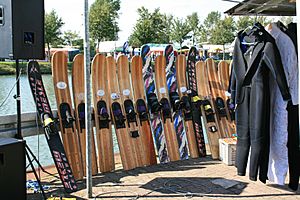
Younger skiers often start on children's skis. These skis are tied together at the front and back. This makes it easier to keep them together. Sometimes, these skis even have a handle for balance. Children's skis are short, usually 114 to 152 cm (45 to 60 inches) long. This size fits a smaller skier. Once you are strong enough, you can choose different skis.
You can use two skis, one on each foot. This is called "combo skiing." Or you can use one ski, with your main foot in front. This is called "slalom skiing." Heavier people generally need bigger skis. The length also changes based on the type of water skiing. For example, jump skis are longer than skis for regular skiing. A trick ski is about 100 cm (40 inches) long and wider than combo skis. It has no fins, which lets you do spins.
Boat
Special boats are used for water ski competitions. Most of these boats have a small, flat bottom. This helps them make very small waves. A true tournament boat has a motor in the middle. This balances the boat for the best wave shape. Some boats for fun skiing have the motor in the back. This creates bigger waves.
Popular boats for fun skiing include bowriders and jetboats.
The boat must go at the right speed. Speeds change based on the skier's weight and skill. For example, a child on two skis might need speeds of 21 to 26 km/h (13 to 16 mph). An adult on one ski might need speeds up to 58 km/h (36 mph). Barefoot skiing needs speeds of about 72 km/h (45 mph). Competition speeds can range from 22 km/h (14 mph) to 58 km/h (36 mph) for slalom skiing. In water ski racing, speeds can reach 190 km/h (118 mph).
The boat needs a ski rope and handle. The rope should be long enough to move around. A good length is about 23 meters (75 feet). The rope length can change based on the type of skiing. The rope and handle attach to the back of the boat. For serious skiers, a metal pole called a ski pylon is used. It's in the center of the boat, in front of the engine. This pole is very strong because skilled skiers can pull hard on the rope.
Staying Safe
Water skiing can be risky, so safety is very important.
You need a skiing space about 60 meters (200 feet) wide. The water should be at least 1.5 to 1.8 meters (5 to 6 feet) deep. The boat should stay at least 30 meters (100 feet) away from docks and other boats. Skiers should always wear a life jacket, no matter how well they swim. Special ski vests let you move easily while still floating.
Most water ski injuries happen to the lower legs, like the knee. Falling at high speed can cause your body to hit the water at odd angles. Another common injury is hitting things in the water, like docks.
The boat must have at least two people. In most places, the observer needs to be at least 12 years old. The driver keeps the boat on a clear path. The observer watches the skier. They tell the driver if the skier falls. If the skier is in the water, the observer raises a "skier down" flag. The skier and observer should agree on hand signals. These signals help them talk easily, like "stop," "speed up," or "I'm OK."
History of Water Skiing
Water skiing was invented in 1922 by Ralph Samuelson. He used wooden boards as skis and a clothesline as a rope. This happened on Lake Pepin in Lake City, Minnesota. Ralph tried different ways to stand on the skis for several days. On July 2, 1922, he found the best way. He learned that leaning back with the ski tips out of the water worked best. His brother Ben pulled him, and they reached 32 km/h (20 mph). Ralph spent 15 years doing shows and teaching water skiing.
Ralph tried different things for his skis. First, he used barrel parts. Then he tried snow skis. Finally, he made his own skis from wood. The bindings were leather straps. The rope was a long window cord. Ralph never patented his ski designs.
The first patent for water skis went to Fred Waller in 1925. He called his skis "Dolphin Akwa-Skees." These skis were made of special dried wood. In 1940, Jack Andresen patented the first trick ski. This ski was shorter and had no fins.
In 1928, Don Ibsen made his own water skis. He didn't know about Samuelson or Waller. In 1941, Don Ibsen started the first water ski club in America. It was called The Olympic Water Ski Club in Seattle, Washington. Ibsen was a great showman and helped make water skis. He also promoted the sport. In 1983, he was put into the Water Ski Hall of Fame.
Water skiing was not well known for a few years. Then, Ralph Samuelson started doing water ski shows. He performed from Michigan to Florida. In 1966, the American Water Ski Association officially said Ralph Samuelson was the first water skier. He was also the first ski racer and the first to organize a water ski show.
Around the same time, in 1929, a Swedish engineer named Gunnar Ljungström started water skiing. He was good at slalom moves. In 1930, he showed water skiing to the public in Sweden.
Water skiing became famous worldwide thanks to Dick Pope, Sr.. He is often called the "Father of American Water Skiing." He started Cypress Gardens in Winter Haven, Florida. Pope made his park famous with many photos of water skiers. These photos appeared in magazines around the world in the 1940s and 1950s. This helped water skiing become popular. He was also the first to jump over a wooden ramp on water skis in 1928. His son, Dick Pope, Jr., invented barefoot skiing. Both are in the Water Ski Hall of Fame. Today, Winter Haven, Florida, is still a key city for water skiing.
Water skiing has grown a lot. Tournaments and competitions are now held. Water skiing was even an exhibition sport in the 1972 Summer Olympics. The first National Show Ski Tournament was in 1974. The first college water ski championships were in 1979. Ten years later, the first competition for people with disabilities was held.
In 2001, Hani Audah designed the first water ski with carbon fiber. It was first used in slalom skiing tournaments in 2003.
Water Skiing Competitions
Orlando, Florida is known as the world capital for competitive water skiing. Competitive water skiing has three main events: slalom, jump, and trick.
Slalom Skiing
In slalom skiing, you use only one ski. Your feet face forward, one in front of the other. Slalom skis are narrow and long. Their length depends on your height and weight. The bindings can be rubber or plastic. They might look like snow ski bindings or rollerblade boots.
Slalom skiing involves going around a course of buoys. A full course has 26 buoys. You must go between entrance gates at the start and end. Then, you weave around 6 turn buoys in a zigzag pattern. The other buoys help the boat driver stay straight. For a tournament to count, the course must be measured carefully.
Each time you complete a pass, it gets harder. The boat speeds up by 3 km/h (2 mph). This continues until it reaches the top speed for your age and gender. For women, it's 55 km/h (34 mph). For men, it's 58 km/h (36 mph). After reaching top speed, the rope is shortened. This makes it harder to reach the buoys. In a tournament, you keep going until you fall or miss a buoy.
Your score depends on how many buoys you clear. It also depends on the boat's speed and the rope's length. Professional skiers often start at the fastest speed. They use a rope that is already shortened. The skier who clears the most buoys wins.
The turn buoys are 11.5 meters (38 feet) from the course center. When the rope is shortened, skiers must use their speed to swing wide. This helps them get their ski around the next buoy. At short rope lengths, skiers use huge muscle strength. They can feel loads up to 600 kg (1,300 lb). Their top speeds can be more than double the boat's speed. Pro men can reach over 116 km/h (72 mph). Each turn can create about 4 G's of force. Slalom skiers use their bodies like a lever to handle these forces.
Jump Skiing
Water ski jumpers use two long skis to go over a ramp. They try to travel the farthest distance. In a tournament, skiers get three tries to hit the ramp. The winner is the skier who jumps the farthest and lands successfully. Only distance matters, not style.
Water ski jumps have specific sizes. The ramp height can be changed. Skiers can choose their boat speed and ramp height. However, there are maximums based on age and gender. Professional jumpers have a top boat speed of 58 km/h (36 mph). The ramp height must be between 1.5 and 1.8 meters (5 and 6 feet). As a jumper nears the ramp, they zigzag behind the boat. This builds speed and angle. When they hit the ramp, they are usually going over 112 km/h (70 mph). The pull on the rope can be over 600 kg (1,300 lb).
Trick Skiing
Trick skiing is seen as the most technical water skiing event.
Trick skiers use small, oval-shaped skis. Beginners often use two skis. More advanced skiers use one. The trick ski is shorter and wider. It has a front binding facing forward. The back binding faces at a 45-degree angle. The bottom is smooth, which helps it turn on the water. Trick skis must be a single ski without fins. This lets skiers do tricks on the water and in the air.
In a tournament, skiers get two 20-second runs. They perform a series of tricks they choose. One run is for hand tricks. These include turns on the water, rotations over the boat's wake, and flips. The second run is for toe tricks. These are done by doing wake turns and rotations while holding the handle with only a foot. A trick cannot be repeated. Each trick has a point value. Judges watch and give points for each trick done correctly. The skier with the most points wins.
Barefoot Water Skiing
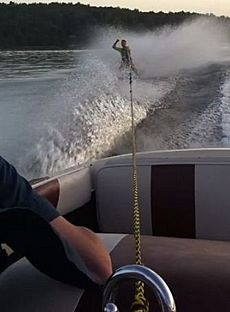
A barefoot water skier should wear a wetsuit instead of a life jacket. The wetsuit covers more of the body. This helps if you fall at high speed. The wetsuit also lets you start by lying on your back in the water. Unlike a normal life jacket, a "barefoot wetsuit" helps you glide on your back once you go fast enough. It's often thicker in the back, rear, and chest for floating and absorbing impact.
Barefoot skiing needs higher speeds. This is because your feet are smaller than skis, so they provide less lift. A simple rule for barefoot speed is: (your weight in pounds / 10) + 18 = speed in mph. For example, a 79 kg (175 lb) person would need about 57 km/h (35.5 mph).
Another tool for barefoot skiing is the barefoot boom. This is a stable aluminum bar on the side of the boat. You can attach a short rope to it or hold the bar directly. You are close to the boat, which is great for learning. Once you get good, you can go behind the boat with a long rope.
Beginners can wear shoes to start. This lowers the needed speed. It also helps prevent foot injury from choppy water. It can help you learn better technique.
Show Skiing
Show skiing is where skiers do tricks like gymnasts while being pulled by a boat. Common show acts include pyramids, ski doubles, freestyle jumping, and swivel skiing. Show skiing is usually part of water ski shows. These shows have costumes, music, and an announcer. Show teams can also compete in regional or national events.
The first organized show was in 1928. The World Show Ski Championship happens every two years. It started in 2012. Teams from Australia, Belgium, Canada, China, and the United States have competed.
Freestyle Jumping
Freestyle jumping is often part of show skiing. The goal is to go off a jump, do a stunt, and land back on the water. Common freestyle stunts include a heli (a 360-degree spin), a flip (forward), a gainer (a back flip), and a möbius (a back flip with a 360-degree spin).
Ski Racing
Water ski racing involves 1 or 2 skiers per boat. They race around a course behind fast boats. Races can be a certain number of laps or on long river courses. Races can be timed, like 20 minutes or up to 1 hour. Some races are over 100 km (62 miles) long.
Speeds vary but can reach up to 200 km/h (124 mph). Boats are usually 19 to 21 feet long. Outboard motors are often 300 horsepower. Inboard motors can be around 1,300 horsepower.
Australia is known for ski racing. It hosts some of the world's biggest and fastest races. Australia also has a history of winning many world championships.
Current world championship races include men's and women's Formula 1 (unlimited) and Formula 2 (limited to single engine, 300 hp outboards). There are also junior classes for skiers under 16.
Some of the biggest races are the Southern 80 in Australia, the Diamond Race in Belgium, and the Catalina Ski Race in the USA. Races can have from 10 to 150 boats competing.
Disabled Water Skiing
Disabled water skiing uses special equipment or changes to allow people with disabilities to compete. Seated water skis, special handles, and audio slalom gear are used for different disabilities.
|
See also
 In Spanish: Esquí acuático para niños
In Spanish: Esquí acuático para niños


